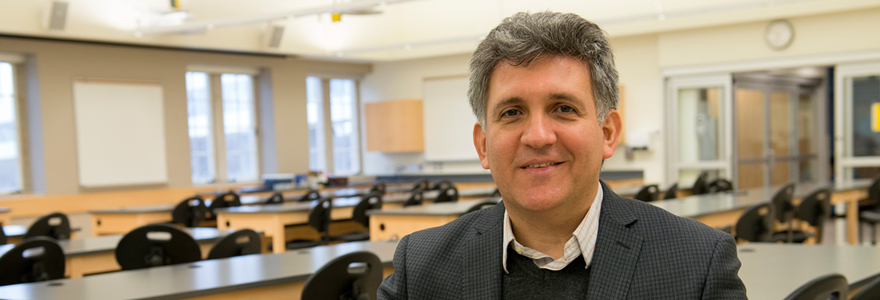Mapping the wired brain

Researcher Dr. Julio Martinez- Trujillo, PhD, is studying the brain circuits affected by autism. His personal motivation to investigate the disorder is anything but ordinary
by Emily Leighton, MA'13
Many of Dr. Julio Martinez-Trujillo’s trips to the supermarket turn into interesting social experiments. Among the produce and packaged food aisles, he finds his most compelling research subjects: babies.
It’s the eye contact that strikes him about these tiny humans—the hard-wired response to lock their gaze with another person, even a stranger in the check-out line.
“Gaze behaviour is very important in a child,” he explained. “Humans learn by imitating behaviour and facial expressions. Our early life communication and learning starts with gaze contact.”
These supermarket expeditions are fascinating for Dr. Martinez-Trujillo as a researcher at Robarts Research Institute, and also as a parent. He has a four-year-old daughter who has autism.
“As a child with autism, she can’t stand to look someone in the eyes or she gets totally overwhelmed,” he said. “She has beautiful greenish-grey eyes, but she has not looked at me for more than two seconds since she was born.”
What’s remarkable about this personal story is how Dr. Martinez-Trujillo, the newly appointed Provincial Endowed Academic Chair in Autism at the Schulich School of Medicine & Dentistry, is applying his own experience at home to his work in the lab. The birth of his daughter motivated him to employ his expertise in neurophysiology to the study of autism.
A clinical neurophysiologist by training with a doctoral degree in neurobiology, Dr. Martinez-Trujillo has spent much of his research career studying how the brain’s electrical circuits implement attention and control gaze. “We pay attention to and look at things that are important to us,” he explained. “This importance is determined by patterns of brain connectivity formed during development and shaped by what brings us joy, satisfaction and reward.”
“How different parts of the brain are connected determines how we perceive,
think and act.” - Julio Martinez-Trujillo
In his role as a scientist at Robarts and Western University’s Brain and Mind Institute, he is taking these research themes in a new direction. “I think I can contribute a lot because I have tools that can be quite unique and a strong motivation to do this type of work,” he said.
Among these tools and techniques is the emerging area of optogenetics, a research method that uses light to control the activity of brain cells, circuit function and behaviour. Dr. Martinez- Trujillo also incorporates microchips in his research to measure the activity of the hundreds of brain cells within a single circuit.
“How different parts of the brain are connected determines how we perceive, think and act,” he explained. “Mapping brain circuits is similar to the way an electrician would probe the circuit of a house. We send pulses from one region to another and then we can see how these two parts are connected.”
A form of reverse engineering, Dr. Martinez-Trujillo’s lab retraces the electrical activity from the muscles that produce behaviour to the brain circuits that are responsible for activating these muscles.
“What I’m trying to do is look at the specific brain circuits that are affected during autism and understand how the circuitry is wired,” he said. “This approach narrows down the problem to a specific circuit and identifies if something is damaged, missing or misconnected.”
Once these circuit issues are identified, the next step is to discover how to fix them. In the future, this research will guide targeted interventions to prevent circuit dysfunction, improving quality of life for patients and their families
With such a personal stake in his work, Dr. Martinez-Trujillo is positive yet pragmatic. The word he uses to express his outlook is empathy, a capacity to know first-hand what it is like to care for a child with autism. It gives the researcher a sense of purpose and resolve.
“It’s not that I want to cure my daughter, that is not the point,” he explained. “But I want to improve her quality of life and the lives of other children with autism. I want to prevent this from happening to other families.”








